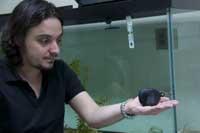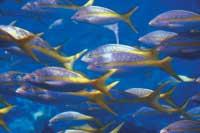Fish groups following a robotic leader

The team of American researchers believes that creating an “artificial leader” for fish can be of great importance. But their goals go beyond anticipating with these devices the fish groups of a large aquarium and getting everyone into a network. In fact, they believe that with the small robot they use between their hands, fish would also have time to avoid or move away from dangerous areas such as power plant turbines.
According to the researchers, bird balances could also be guided from one place to another with similar robotic devices, for example, if the areas in which they live were destroyed, and do not rule out that one day the human being can serve to get out of a fire. But these are still hypotheses.
Several robotic swimmers have previously been developed, such as pollution control, and numerous attempts have been made to shape these devices to real species. However, the prototype of the robot they have now presented resembles a hand grenade. “In this sense, ours is much more basic than others,” the researchers say.

However, it seems that fish do not give much importance. According to New York researchers, the characteristics that differentiate fish leaders are as follows: they shake the tail faster, recede and advance, accelerating movements to capture the attention of other fish, who join the group and take the group’s “leadership”.
Remote control
New York University is studying the behavior of ceba-fed fish in some circular tanks based on fluid dynamics principles. They have recently released their work in the Journal of the Royal Society Interface.
They have created a fish-like tool that quietly swims by remote control. You can swim at a single depth, the next step would be to create devices capable of diving and emerging.
In addition to fish of other species and sizes, researchers have found that balances would accept a greater robotic leader. They have sought the locomotion of the device to be similar to that of live fish. For this purpose, ion polymers have been used that, as a consequence of electrical stimuli from a battery, increase or decrease and propel the robot.

Based on innovative propulsion systems such as this one, the possibility of using ion polymers to obtain energy in aquatic environments is also being studied. Its objective is to develop underwater microsensors that take advantage of energy from small turbulence and vibrations. In addition, the fish robot's own technology is helping researchers develop new artificial muscles that work without battery
Meanwhile, research advances. Among other things, they want to know closely the intelligence of the fish, their calculation capacity and their ways of escaping from predators, and then get more clues around other living species.
Published in 7K.
Buletina
Bidali zure helbide elektronikoa eta jaso asteroko buletina zure sarrera-ontzian











